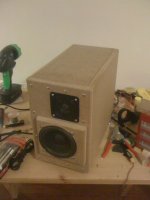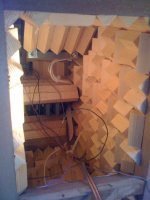Well I went and did something silly. What can I say, I blame it on the beer.....
I was going to make a pair of desktop active speakers for my laptop, since I've paid for Sky.fm premium and don't have a good way to listen to it...
So, I started off looking at the Seas 5" coaxial driver, and then thought to add a lower frequency woofer for a 3 way. I found some cheap 6.5" woofers on PE:
6-1/2" Subwoofer Speaker 299-114
actually listed as a subwoofer for $10 each. I modeled them and though the box is a little large, -3dB is 45 Hz. I was going to cross these over at about 300 Hz to the Seas coaxial but I just couldn't pull the trigger on those $140 each drivers. I'm sure they are super good.... anyway, I got to looking around PE and found these:
Dayton Audio RS75-4 3" Reference Full-Range Driver 4 Ohm 295-380
for about $20 each. They are 3" (2" cone) "full range" drivers with no real bass and not enough excursion to be useful below about 500 Hz. So, I've got a two way with a crossover of 500 Hz. Hmmm... sounds like a cool idea, except the box is a little large at over 0.75 cu ft... but the upside is that I won't need a subwoofer, so not so bad.
I was going to make it active also, but the idea of having to mess with all that crap (amps, crossovers, power cords, etc) made me decide to go passive on the crossover. On the plus side, both drivers are about 83dB sensitive, so no L pad is needed for the 3" driver. I can't really hear above 10kHz so I don't care about that huge bump in the 3" driver's response curve... at least I hope I don't care... hell, if it's a problem then I can find a solution some way...
Parts are on the way, so we shall see what happens...
I was going to make a pair of desktop active speakers for my laptop, since I've paid for Sky.fm premium and don't have a good way to listen to it...
So, I started off looking at the Seas 5" coaxial driver, and then thought to add a lower frequency woofer for a 3 way. I found some cheap 6.5" woofers on PE:
6-1/2" Subwoofer Speaker 299-114
actually listed as a subwoofer for $10 each. I modeled them and though the box is a little large, -3dB is 45 Hz. I was going to cross these over at about 300 Hz to the Seas coaxial but I just couldn't pull the trigger on those $140 each drivers. I'm sure they are super good.... anyway, I got to looking around PE and found these:
Dayton Audio RS75-4 3" Reference Full-Range Driver 4 Ohm 295-380
for about $20 each. They are 3" (2" cone) "full range" drivers with no real bass and not enough excursion to be useful below about 500 Hz. So, I've got a two way with a crossover of 500 Hz. Hmmm... sounds like a cool idea, except the box is a little large at over 0.75 cu ft... but the upside is that I won't need a subwoofer, so not so bad.
I was going to make it active also, but the idea of having to mess with all that crap (amps, crossovers, power cords, etc) made me decide to go passive on the crossover. On the plus side, both drivers are about 83dB sensitive, so no L pad is needed for the 3" driver. I can't really hear above 10kHz so I don't care about that huge bump in the 3" driver's response curve... at least I hope I don't care... hell, if it's a problem then I can find a solution some way...
Parts are on the way, so we shall see what happens...
Last edited:
Thanks a lot for all the simulations and recommendations. I was kind of busy with work and I hadn't worked on selecting the woofer and tweeter yet. And once the amps are delivered to me I will have more questions.
Before moving on here are a few very basic questions:
1)Is Ne5322 + LS3886 and integrated amp or a buffered poweramp? (the pcb I bought) ?
I was hoping that fit was an integrated amp.
2)If there were no other choices, would you prefer a 4 inch + Tweeter or 2x 3 incher + Tweeter setup's? And why?
3) If I recess a tweeter by 1cm, how will the nearby wood edges effect the sound especially vertical dispersion? Or there will be no effects as the center of the tweeter will be to far away?
best regards
Mertol
br
Mertol
Before moving on here are a few very basic questions:
1)Is Ne5322 + LS3886 and integrated amp or a buffered poweramp? (the pcb I bought) ?
I was hoping that fit was an integrated amp.
2)If there were no other choices, would you prefer a 4 inch + Tweeter or 2x 3 incher + Tweeter setup's? And why?
3) If I recess a tweeter by 1cm, how will the nearby wood edges effect the sound especially vertical dispersion? Or there will be no effects as the center of the tweeter will be to far away?
best regards
Mertol
br
Mertol
2)If there were no other choices, would you prefer a 4 inch + Tweeter or 2x 3 incher + Tweeter setup's? And why?
3) If I recess a tweeter by 1cm, how will the nearby wood edges effect the sound especially vertical dispersion? Or there will be no effects as the center of the tweeter will be to far away?
best regards
br
Mertol
2) Oops, sorry. edit: I would probably go with a 4" + a tweeter. The choice would depend on the sensitivity of the tweeter I think. Adding a second 3" driver increases the total output by I think 6 dB, so if you've got a tweeter that is +6 dB more sensitive than the woofer, you can double up to bring them closer.
3) Diffraction is a big subject. Basically, as I understand it, you can bevel the edges of the cabinet to reduce the effects and/or apply acoustical foam to the face of the cabinet to the edge.
Last edited:
Schematics and simulation using LTspiceIV, substractive filter approach using an analog delay line in the tweeter section for compensating the minibass phase lag around the crossover frequency.
The analog delay line is matched to the Visaton CP13 tweeter exhibiting a 4 ohm impedance. A RC network is put in parallel with the tweeter, for ensuring a stable impedance in the ultrasonic frequencies.
Best simulation results are obtained when using 22 µH coils in the analog delay line. In such case, the capacitors can be 2.2 µF (one single bipolar cap) or 3.0 µF (three 1 µF in parallel).
Take notice that the present simulation bases on the fact that the tweeter and the minibass have their acoustic centers aligned. This is however not the case when flush mounting the tweeter and the minibass. In such case, the minibass emission centre is about 15 mm recessed inside the box, while the tweeter emission centre is essentially at the box surface.
This means that a real world application will need more delay in the tweeter section for a) compensating the acoustic centres misalignments and b) compensating the minibass phase lag around the crossover frequency.
The analog delay line is matched to the Visaton CP13 tweeter exhibiting a 4 ohm impedance. A RC network is put in parallel with the tweeter, for ensuring a stable impedance in the ultrasonic frequencies.
Best simulation results are obtained when using 22 µH coils in the analog delay line. In such case, the capacitors can be 2.2 µF (one single bipolar cap) or 3.0 µF (three 1 µF in parallel).
Take notice that the present simulation bases on the fact that the tweeter and the minibass have their acoustic centers aligned. This is however not the case when flush mounting the tweeter and the minibass. In such case, the minibass emission centre is about 15 mm recessed inside the box, while the tweeter emission centre is essentially at the box surface.
This means that a real world application will need more delay in the tweeter section for a) compensating the acoustic centres misalignments and b) compensating the minibass phase lag around the crossover frequency.
Attachments
-
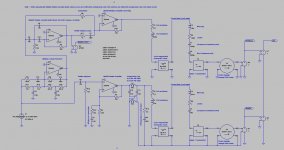 1st order crossover - substractive & analog delay (schema).jpg81.7 KB · Views: 245
1st order crossover - substractive & analog delay (schema).jpg81.7 KB · Views: 245 -
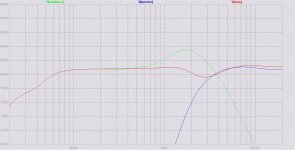 1st order crossover - substractive & analog delay (gain).jpg87.7 KB · Views: 243
1st order crossover - substractive & analog delay (gain).jpg87.7 KB · Views: 243 -
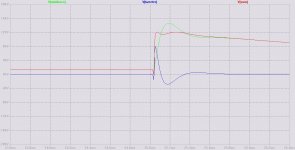 1st order crossover - substractive & analog delay (step response).jpg72.6 KB · Views: 244
1st order crossover - substractive & analog delay (step response).jpg72.6 KB · Views: 244 -
2-way active (1st order crossover).zip527.8 KB · Views: 43
2)If there were no other choices, would you prefer a 4 inch + Tweeter or 2x 3 incher + Tweeter setup's? And why?
br
Mertol
I think this driver would be ideal for you:
Seas Prestige L12RE/XFC (H1602) 5" Alum/Fabric Coaxial
$140 each at Madisound. It's perfect for near field listening and designed for small (even tiny) cabinets. No need for fancy time alignment either!
Update
For a quicker start and not to ruin expensive drives, I bought some lower end units from a local shop.
2x Westra WDT-25-508
90db, Fs 1250, good flatish response with roll of at 18khz
2x Philips 4.5 inch woofers (seller told me that they are philips)
Told to be 89db, initial listening test shows response rising after 5-6khz
As I didn't have the parameters for the woofer/midrange I did my best in calculating them. Here they are :
Re : 6.5 (8 ohm is written at the back ??)
Fs : 72hz (I am kind of sure about this as it's pretty easy measurement)
Qms : 4.96
Qes : 0.53
Qts : 0.47
I am not sure about the Q parameters as this was the first time I measured them...
I used the added mass method to determine VAS and it's calculated as 13l, not quite sure as this is not a quite accurate method.
I bought everything I need to build the speaker right now. So I can move on with the box design.
After initial calculations I have decided to go with a 8 liter (Net box) (After internal bids are removed) narrow baffle with mirrored image, tweeter and mid slightly off center.
So this speaker will be a small 2 way with a slightly higher XO point for sure as the tweeter's FS is a lithe bit high.
Here are my questions :
Does it worth to make the box ported? I definitely like sealed boxes but I am a little afraid that box will be lacking without a port.
I need recommendations about porting or not porting and if you recommend porting what port length and diameter is recommended?
I plan to finish the drawings and get the wood cut monday latest. Any advice very welcome.
best regards
Mertol
For a quicker start and not to ruin expensive drives, I bought some lower end units from a local shop.
2x Westra WDT-25-508
90db, Fs 1250, good flatish response with roll of at 18khz
2x Philips 4.5 inch woofers (seller told me that they are philips)
Told to be 89db, initial listening test shows response rising after 5-6khz
As I didn't have the parameters for the woofer/midrange I did my best in calculating them. Here they are :
Re : 6.5 (8 ohm is written at the back ??)
Fs : 72hz (I am kind of sure about this as it's pretty easy measurement)
Qms : 4.96
Qes : 0.53
Qts : 0.47
I am not sure about the Q parameters as this was the first time I measured them...
I used the added mass method to determine VAS and it's calculated as 13l, not quite sure as this is not a quite accurate method.
I bought everything I need to build the speaker right now. So I can move on with the box design.
After initial calculations I have decided to go with a 8 liter (Net box) (After internal bids are removed) narrow baffle with mirrored image, tweeter and mid slightly off center.
So this speaker will be a small 2 way with a slightly higher XO point for sure as the tweeter's FS is a lithe bit high.
Here are my questions :
Does it worth to make the box ported? I definitely like sealed boxes but I am a little afraid that box will be lacking without a port.
I need recommendations about porting or not porting and if you recommend porting what port length and diameter is recommended?
I plan to finish the drawings and get the wood cut monday latest. Any advice very welcome.
best regards
Mertol
As I didn't have the parameters for the woofer/midrange I did my best in calculating them. Here they are :
Re : 6.5 (8 ohm is written at the back ??)
Fs : 72hz (I am kind of sure about this as it's pretty easy measurement)
Qms : 4.96
Qes : 0.53
Qts : 0.47
I am not sure about the Q parameters as this was the first time I measured them... I used the added mass method to determine VAS and it's calculated as 13l, not quite sure as this is not a quite accurate method.
Please attach the two impedance curves in function of the frequency : with and without additional mass. And tell the weight of the additional mass.
It's not so easy. Ported may need a completely different volume than 8 liter.After initial calculations I have decided to go with a 8 liter. I need recommendations about porting or not porting and if you recommend porting what port length and diameter is recommended?
P.S. How much is the linear Xmax ? What is the effective membrane diameter ?
Answers to questions, status update and more questions
I don't have a impedance curve as the only program I use to use was speaker workshop and it's help did not work in windows 7 so I was unable to make a proper jig. (If anyone knows the diagram of the speaker workshop basic jig, plaese help me)
I measured everything using a nice multimeter and a digital scope.
If I figure out the speaker workshop jig, I will add them tomorrow.
So far I had the wood cut. I am using 2 layers of 2/3 inch MDF. It seems like active speakers with two mdf layers was quite hard to build as a lot of thing needs to be sorted out before I can actually start gluing it.
Althoug it's a lot more logical I think I will not modify the basic amplifier circuit and instead I will build a 2nd order passive line level filter. This way
A) I can fix things easier if the amp breaks. (if I like the sound of the speaker I will order 2 spare amp boards)
B) I can play with the XO until I am satisfied
C) I think I need second order as I hear that woofer is ringing sand beaming way too much at higher frequencies and tweeter has a high Fs.
Can any help me on the following issues?
1) Easiest way to determine the sensivity of the woofer without mounting it to a box?
2) How can I design a passive 12db/octave XO at a given frequency?
3) Is it possible to use passive line level XO , at the input of the amplifier , i.e. not between pre and power sections?
best regards
Mertol
I don't have a impedance curve as the only program I use to use was speaker workshop and it's help did not work in windows 7 so I was unable to make a proper jig. (If anyone knows the diagram of the speaker workshop basic jig, plaese help me)
I measured everything using a nice multimeter and a digital scope.
If I figure out the speaker workshop jig, I will add them tomorrow.
So far I had the wood cut. I am using 2 layers of 2/3 inch MDF. It seems like active speakers with two mdf layers was quite hard to build as a lot of thing needs to be sorted out before I can actually start gluing it.
Althoug it's a lot more logical I think I will not modify the basic amplifier circuit and instead I will build a 2nd order passive line level filter. This way
A) I can fix things easier if the amp breaks. (if I like the sound of the speaker I will order 2 spare amp boards)
B) I can play with the XO until I am satisfied
C) I think I need second order as I hear that woofer is ringing sand beaming way too much at higher frequencies and tweeter has a high Fs.
Can any help me on the following issues?
1) Easiest way to determine the sensivity of the woofer without mounting it to a box?
2) How can I design a passive 12db/octave XO at a given frequency?
3) Is it possible to use passive line level XO , at the input of the amplifier , i.e. not between pre and power sections?
best regards
Mertol
status update
At last, finished the first enclosure and the second one is on the go. While I built the second one, I plan to fine tune the XO.
Some pictures attached.
It's 4/3 inch thick mdf and weights 18kg, more than some of the towers I owned. All the interior has lined with triangles on six of the walls to increase surface and kill parallel walls. Tweeter is in a %99 airtight sub enclosure. Internal integrated amplifier is a LM1875T + NE5322 supported by a large 120watt transformer.
Voice coils of tweeter and and mid bass is aligned by adding a third 2/3 inch thick mdf for the mid bas driver. As advised I tried to keep the distance between mid and tweeter very close, as close as mechanically possible with my tools.
I rounded all edges, keep all units off center, with different distances from each edge.
I impleted a switch at the rear of the system so that an internal or an external XO can be selected.
As I thought that this enclosure deserves better drives, I made the front baffle detachable (inner baffle is fixed however, but will permit me to use nearly %99 of the tweeters and %100 of 4-4.5 inch mid bass) The exterior baffle is fixed by 16 screws and looks quite tight to me.
Here are my initial tests :
It looks like the mid-bass is more capable than I thought initially. Goes well down to 55hz with reasonable output, while the measured vas was 72 hz.
Tweeter has a 90db sensivity while the mid bass is 89 db average. I will do better measurements in a more controlled environment in this week.
I haven't tested a XO yet, however I think I will start with a 3khz 1st order, as mid-bass has reasonable out put unto 14khz, while it certainly beams above 7-8khz.
I seem to have one major problem. There seems to be too much hiss from the internal integrated amp, especially when there is not much input signal. I think this is because line level cables I used are unshielded and located very close to transformer. Any other ideas?
Here are a few questions I'd like to ask.
1) I haven't flush mount the mid bass as my rabbeting bids haven't arrived. What will I gain if I flush mount the mid bass and what will I loose if I don't?
2) Is starting with a 3khz 1st order XO reasonable? (I will try to measure each driver individually, but I couldn't find reasonable microphone yet.
3) What are my finishing options, considering that I have several rCa inputs, a switch some other stuff at the back side of the unit, that I can not remove.
best regards
Mertol
At last, finished the first enclosure and the second one is on the go. While I built the second one, I plan to fine tune the XO.
Some pictures attached.
It's 4/3 inch thick mdf and weights 18kg, more than some of the towers I owned. All the interior has lined with triangles on six of the walls to increase surface and kill parallel walls. Tweeter is in a %99 airtight sub enclosure. Internal integrated amplifier is a LM1875T + NE5322 supported by a large 120watt transformer.
Voice coils of tweeter and and mid bass is aligned by adding a third 2/3 inch thick mdf for the mid bas driver. As advised I tried to keep the distance between mid and tweeter very close, as close as mechanically possible with my tools.
I rounded all edges, keep all units off center, with different distances from each edge.
I impleted a switch at the rear of the system so that an internal or an external XO can be selected.
As I thought that this enclosure deserves better drives, I made the front baffle detachable (inner baffle is fixed however, but will permit me to use nearly %99 of the tweeters and %100 of 4-4.5 inch mid bass) The exterior baffle is fixed by 16 screws and looks quite tight to me.
Here are my initial tests :
It looks like the mid-bass is more capable than I thought initially. Goes well down to 55hz with reasonable output, while the measured vas was 72 hz.
Tweeter has a 90db sensivity while the mid bass is 89 db average. I will do better measurements in a more controlled environment in this week.
I haven't tested a XO yet, however I think I will start with a 3khz 1st order, as mid-bass has reasonable out put unto 14khz, while it certainly beams above 7-8khz.
I seem to have one major problem. There seems to be too much hiss from the internal integrated amp, especially when there is not much input signal. I think this is because line level cables I used are unshielded and located very close to transformer. Any other ideas?
Here are a few questions I'd like to ask.
1) I haven't flush mount the mid bass as my rabbeting bids haven't arrived. What will I gain if I flush mount the mid bass and what will I loose if I don't?
2) Is starting with a 3khz 1st order XO reasonable? (I will try to measure each driver individually, but I couldn't find reasonable microphone yet.
3) What are my finishing options, considering that I have several rCa inputs, a switch some other stuff at the back side of the unit, that I can not remove.
best regards
Mertol
Now it is time to measure the Bode plot of the individual drivers. Get a 2-channel FFT analyzer producing a gain curve and a phase curve.
Can you help me on which SW I should use (I prefer free), I have a MAC and PC with win 7. I don't happen to have any hi-end microphones but have a few decent vintage mikes hanging around.
I think I will need a sw that can measure gated response as my workplace does echo too much and my other study room is too narrow can have a lot of early reflections.
I think I will need a sw that can measure gated response as my workplace does echo too much and my other study room is too narrow can have a lot of early reflections.
SpectraLab 4.32Can you help me on which SW I should use (I prefer free), I have a MAC and PC with win 7.
Any 2-terminal electret capsule is good. See here : A measurement microphone for taking acoustic measurements using the Panasonic WM-61A electret.I don't happen to have any hi-end microphones but have a few decent vintage mikes hanging around.
Of course you need a mike preamp using a BC549 (or any other low power NPN BJT) and a power supply (for the mike and the preamp) like two 1.5 V batteries in series.
As your drivers are quite small, you can put the mike at a reduced distance like 30cm. As you are equipped with a brain, you can make several measurements in several situations for determining the reliable portion of the measured gain and phase.I think I will need a sw that can measure gated response as my workplace does echo too much and my other study room is too narrow can have a lot of early reflections.
I think spectra lab is not free and although I don't see the price list, I doubt that it will be free.
Anyway I took the first measurements using speaker workshop (I know it's ancient) and a IOS based fft analyzer.
My first problem seems to be the 50hz humm. I need to find a way to cut it. The transformer is below the amplifier pcb and very close to the cables and I think I should have shielded the cables. That's going to be problematic right now, as most connectors are embedded into 4/3 inch wood with very little room for resoldering.
I think I will use aluminum folio to shield them while they are still soldered and wrap the aluminum with 2 layers of electric band for isolation and ground the shield (don't know how)
IF I could have found a cover for the transformer that would also help me a lot.
Anyway FFT analyze shows a dip around 260hz. This is quite nu natural and I am unable to figure out the reason, hoping that this is the room interacting.
There are a few peaks at 6kzh , 8 kHz and a smaller one at 10khz.
Middbass, with a few cone breakups has a usable response to 12-13khz and tweeter can go down to 1.1khz.
So I have builded an 6db XO at 3khz and it sounds wonderful. Due to a very tiny bit of ringing around 6-7khz , I will try to move the XO a little down to 2.6khz and I will also try a 3.5khz XO.
When I have time I will also try the 12db XO's. Perhaps a 6dh high pass on tweeter and a 12db lowpass on the mid bass.
I have one question. I am using very small capacitors. Therefor I think that phase difference will be minimal. So I think that I should wire all speakers straight. Am I correct?
Thanks for all the help..
br
Mertol
Anyway I took the first measurements using speaker workshop (I know it's ancient) and a IOS based fft analyzer.
My first problem seems to be the 50hz humm. I need to find a way to cut it. The transformer is below the amplifier pcb and very close to the cables and I think I should have shielded the cables. That's going to be problematic right now, as most connectors are embedded into 4/3 inch wood with very little room for resoldering.
I think I will use aluminum folio to shield them while they are still soldered and wrap the aluminum with 2 layers of electric band for isolation and ground the shield (don't know how)
IF I could have found a cover for the transformer that would also help me a lot.
Anyway FFT analyze shows a dip around 260hz. This is quite nu natural and I am unable to figure out the reason, hoping that this is the room interacting.
There are a few peaks at 6kzh , 8 kHz and a smaller one at 10khz.
Middbass, with a few cone breakups has a usable response to 12-13khz and tweeter can go down to 1.1khz.
So I have builded an 6db XO at 3khz and it sounds wonderful. Due to a very tiny bit of ringing around 6-7khz , I will try to move the XO a little down to 2.6khz and I will also try a 3.5khz XO.
When I have time I will also try the 12db XO's. Perhaps a 6dh high pass on tweeter and a 12db lowpass on the mid bass.
I have one question. I am using very small capacitors. Therefor I think that phase difference will be minimal. So I think that I should wire all speakers straight. Am I correct?
Thanks for all the help..
br
Mertol
Just an update. I sorted out %90 of the 50hz humm by connecting the ground to real ground (i.e. central heating systems pipe) Did everything else to stop it though.
Anyway system works quite OK wit the 3 kHz passive line level XO and sounds more like a point source.
My rabbeting bits have arrived and I will be flush mounting the mid/bass tomorrow, and continue building the second one.
Anyway system works quite OK wit the 3 kHz passive line level XO and sounds more like a point source.
My rabbeting bits have arrived and I will be flush mounting the mid/bass tomorrow, and continue building the second one.
- Status
- Not open for further replies.
- Home
- Loudspeakers
- Multi-Way
- Need Advice on designing a budget active speaker
